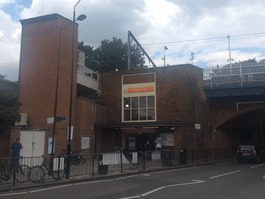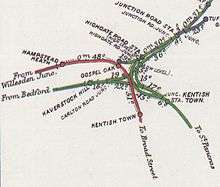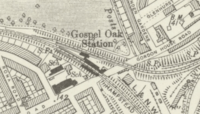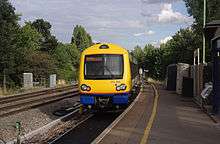Gospel Oak railway station
Gospel Oak railway station is in the London Borough of Camden in north London. It is on the North London Line (NLL) and is also the western passenger terminus of the Gospel Oak to Barking Line - known informally as GOBLIN. Passengers using Oyster cards are required to tap on interchange Oyster card readers when changing between the two lines. The station is in Travelcard Zone 2, and is managed by London Overground which runs all passenger trains at the station.
| Gospel Oak | |
|---|---|
 The station entrance in 2017 | |
 Gospel Oak Location of Gospel Oak in Greater London | |
| Location | Gospel Oak |
| Local authority | London Borough of Camden |
| Managed by | London Overground |
| Owner | Network Rail |
| Station code | GPO |
| DfT category | D |
| Number of platforms | 3 |
| Accessible | Yes[1] |
| Fare zone | 2 |
| National Rail annual entry and exit | |
| 2014–15 | |
| – interchange | |
| 2015–16 | |
| – interchange | |
| 2016–17 | |
| – interchange | |
| 2017–18 | |
| – interchange | |
| 2018–19 | |
| – interchange | |
| Key dates | |
| 1860 | Opened (NLL) |
| 1888 | Opened (GOBLIN) |
| 1926 | Closed (GOBLIN) |
| 1981 | Reopened (GOBLIN) |
| Other information | |
| External links | |
| WGS84 | 51.5552°N 0.1514°W |
History


The station opened in 1860[3] as Kentish Town on the Hampstead Junction Railway from Camden Road to Old Oak Common Junction south of Willesden Junction. It was renamed Gospel Oak in 1867 when a new station more appropriately named Kentish Town was opened about a mile south on the same line (that station is now Kentish Town West). Due to financial constraints a planned connection from the Tottenham and Hampstead Junction Railway to Gospel Oak station was not added until 4 June 1888, some 20 years after that railway opened, and then without a link to the North London Line due to other companies' opposition.
From 1926 to 1981, the station was not a passenger interchange: passenger trains left the Barking line at Tufnell Park and descended the gradient to Kentish Town station. In 1981 that passenger service from Barking was diverted from Kentish Town to Gospel Oak with the terminal platform rebuilt on the north side of the existing station.[4]
The North London Line through Gospel Oak was electrified on the fourth-rail 660 volt DC system in 1916 by the LNWR: in the 1970s that was changed to 750 volt DC third rail. In 1996, the line from Willesden through Gospel Oak to Camden was closed during conversion to 25 kv AC overhead.
Design
The platforms are high above street level with stairs and two lifts, one serving westbound trains, and one serving eastbound trains and the Barking line.[5] The North London Line has two platforms and the Barking line has a short terminal platform north of which are two separate through freight tracks which join the NLL just west of the station. Oyster ticket barriers are in operation.
Services

To allow four-car trains to run on the London Overground network, the North London Line between this station and Stratford closed from February 2010 to 1 June 2010, for installing a new signalling system and for extending 30 platforms. Until May 2011, there was a reduced service with no services on Sundays while the upgrade work continued.[6]
The typical off-peak service at the station in trains per hour is:[7]
- 4 eastbound to Barking
- 6 eastbound to Stratford
- 2 westbound to Clapham Junction
- 4 westbound to Richmond
| Preceding station | Following station | |||
|---|---|---|---|---|
| Terminus | Gospel Oak to Barking Line | towards Barking |
||
towards Richmond or Clapham Junction | North London Line | towards Stratford |
||
| Disused railways | ||||
| Terminus | Tottenham & Hampstead Junction Railway (1868–1915) |
Highgate Road | ||
Connections
London Buses route C11 serves the station.
In arts and music
The two brick skew arch bridges by which the trains cross Gordon House Road are shown in the cover photograph of the 1997 Gospel Oak EP by Irish singer Sinéad O'Connor.
Notes
- This decrease was caused by a change in methodology which reduced the figure by 1.052 million. Without the change, the figure would have been 3,681 million.
References
- "Step free Tube Guide" (PDF). Transport for London. May 2020. Archived (PDF) from the original on 7 August 2020.
- "Station usage estimates". Rail statistics. Office of Rail Regulation. Please note: Some methodology may vary year on year.
- Joe Brown (2006). London Railway Atlas. Ian Allan Publishing.
- http://www.icrs.org.uk/Site/Features/journey_northlondon_two.htm
- "Mayor hails successful bid to make more London Overground stations step free". TfL. 8 December 2011. Retrieved 3 April 2012.
- "London Overground to close from Gospel Oak to Stratford as part of £326m upgrade to deliver longer, more frequent trains". TfL. 15 February 2010. Retrieved 29 May 2011.
- GB eNRT May 2016 Edition, Tables 59 & 62 (Network Rail)
External links
| Wikimedia Commons has media related to Gospel Oak railway station. |
- Train times and station information for Gospel Oak railway station from National Rail